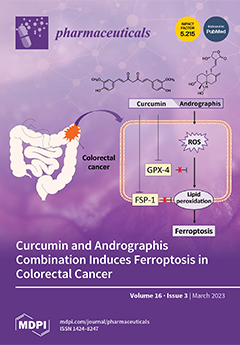The entry of proteins through the cell membrane is challenging, thus limiting their use as potential therapeutics. Seven cell-penetrating peptides, designed in our laboratory, were evaluated for the delivery of proteins. Fmoc solid-phase peptide synthesis was utilized for the synthesis of seven cyclic
[...] Read more.
The entry of proteins through the cell membrane is challenging, thus limiting their use as potential therapeutics. Seven cell-penetrating peptides, designed in our laboratory, were evaluated for the delivery of proteins. Fmoc solid-phase peptide synthesis was utilized for the synthesis of seven cyclic or hybrid cyclic–linear amphiphilic peptides composed of hydrophobic (tryptophan (W) or 3,3-diphenylalanine (Dip) and positively-charged arginine (R) residues, such as [WR]
4, [WR]
9, [WWRR]
4, [WWRR]
5, [(RW)
5K](RW)
5, [R
5K]W
7, and [DipR]
5. Confocal microscopy was used to screen the peptides as a protein delivery system of model cargo proteins, green and red fluorescein proteins (GFP and RFP). Based on the confocal microscopy results, [WR]
9 and [DipR]
5 were found to be more efficient among all the peptides and were selected for further studies. [WR]
9 (1–10 µM) + protein (GFP and RFP) physical mixture did not show high cytotoxicity (>90% viability) in triple-negative breast cancer cells (MDA-MB-231) after 24 h, while [DipR]
5 (1–10 µM) physical mixture with GFP exhibited more than 81% cell viability. Confocal microscopy images revealed internalization of GFP and RFP in MDA-MB-231 cells using [WR]
9 (2–10 μM) and [DipR]
5 (1–10 µM). Fluorescence-activated cell sorting (FACS) analysis indicated that the cellular uptake of GFP was concentration-dependent in the presence of [WR]
9 in MDA-MB-231 cells after 3 h of incubation at 37 °C. The concentration-dependent uptake of GFP and RFP was also observed in the presence of [DipR
5] in SK-OV-3 and MDA-MB-231 cells after 3 h of incubation at 37 °C. FACS analysis indicated that the cellular uptake of GFP in the presence of [WR]
9 was partially decreased by methyl-β-cyclodextrin and nystatin as endocytosis inhibitors after 3 h of incubation in MDA-MB-231 cells, whereas nystatin and chlorpromazine as endocytosis inhibitors slightly reduced the uptake of GFP in the presence of [DipR]
5 after 3 h of incubation in MDA-MB-231. [WR]
9 was able to deliver therapeutically relevant proteins (Histone H2A) at different concentrations. These results provide insight into the use of amphiphilic cyclic peptides in the delivery of protein-related therapeutics.
Full article






